KIA NIRO PLUG-IN HYBRID 2018 Owners Manual
Manufacturer: KIA, Model Year: 2018, Model line: NIRO PLUG-IN HYBRID, Model: KIA NIRO PLUG-IN HYBRID 2018Pages: 616, PDF Size: 18.98 MB
Page 461 of 616
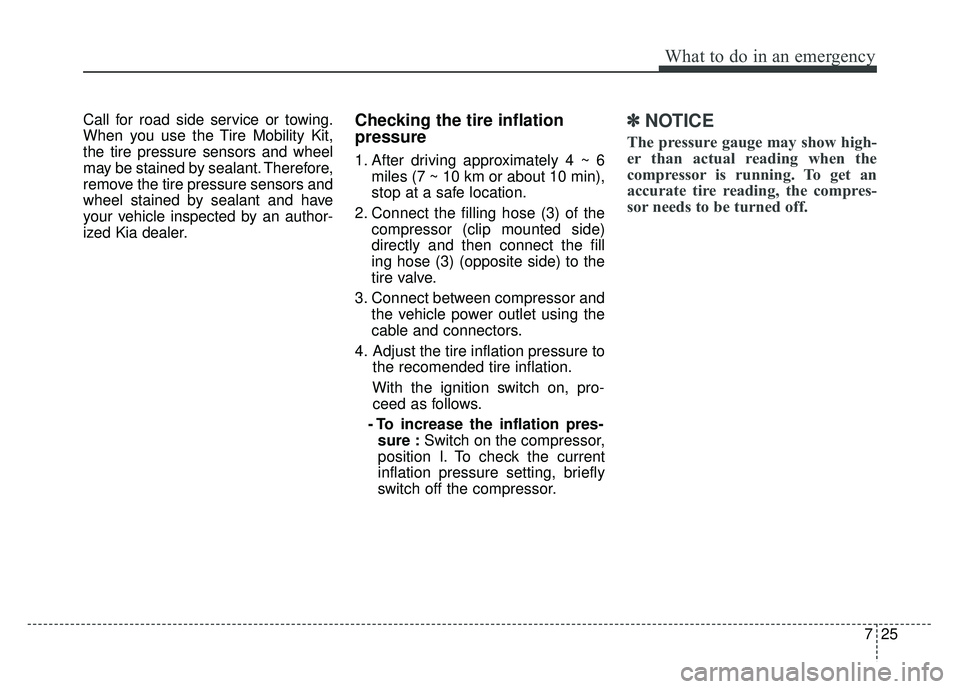
725
What to do in an emergency
Call for road side service or towing.
When you use the Tire Mobility Kit,
the tire pressure sensors and wheel
may be stained by sealant. Therefore,
remove the tire pressure sensors and
wheel stained by sealant and have
your vehicle inspected by an author-
ized Kia dealer.Checking the tire inflation
pressure
1. After driving approximately 4 ~ 6miles (7 ~ 10 km or about 10 min),
stop at a safe location.
2. Connect the filling hose (3) of the compressor (clip mounted side)
directly and then connect the fill
ing hose (3) (opposite side) to the
tire valve.
3. Connect between compressor and the vehicle power outlet using the
cable and connectors.
4. Adjust the tire inflation pressure to the recomended tire inflation.
With the ignition switch on, pro- ceed as follows.
- To increase the inflation pres- sure : Switch on the compressor,
position I. To check the current
inflation pressure setting, briefly
switch off the compressor.
✽ ✽ NOTICE
The pressure gauge may show high-
er than actual reading when the
compressor is running. To get an
accurate tire reading, the compres-
sor needs to be turned off.
Page 462 of 616
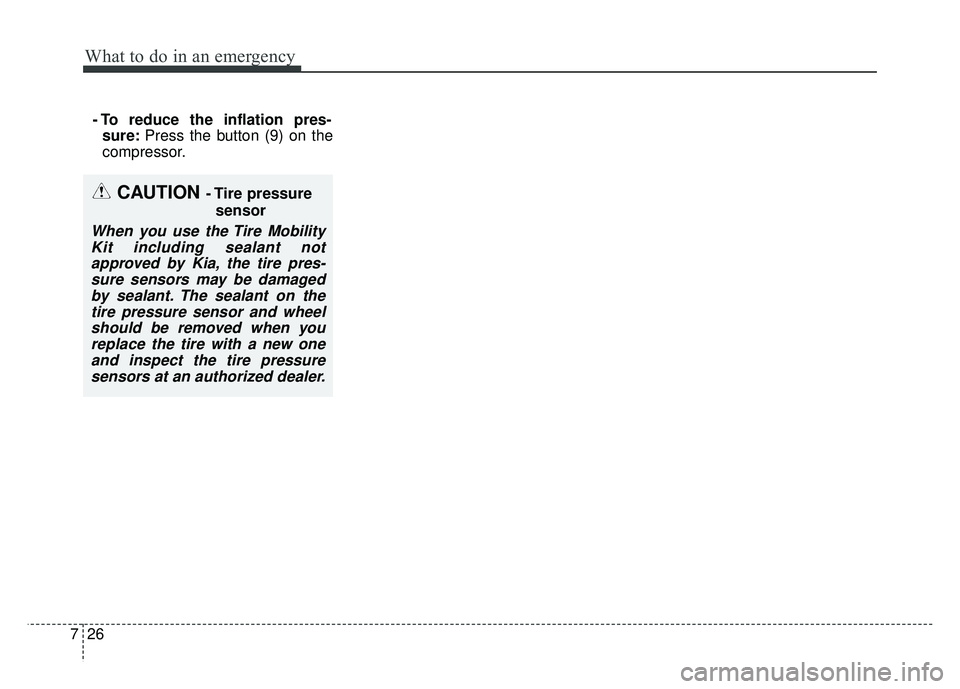
What to do in an emergency
26
7
- To reduce the inflation pres-
sure: Press the button (9) on the
compressor.
CAUTION - Tire pressure
sensor
When you use the Tire MobilityKit including sealant notapproved by Kia, the tire pres-sure sensors may be damagedby sealant. The sealant on thetire pressure sensor and wheelshould be removed when youreplace the tire with a new oneand inspect the tire pressuresensors at an authorized dealer.
Page 463 of 616
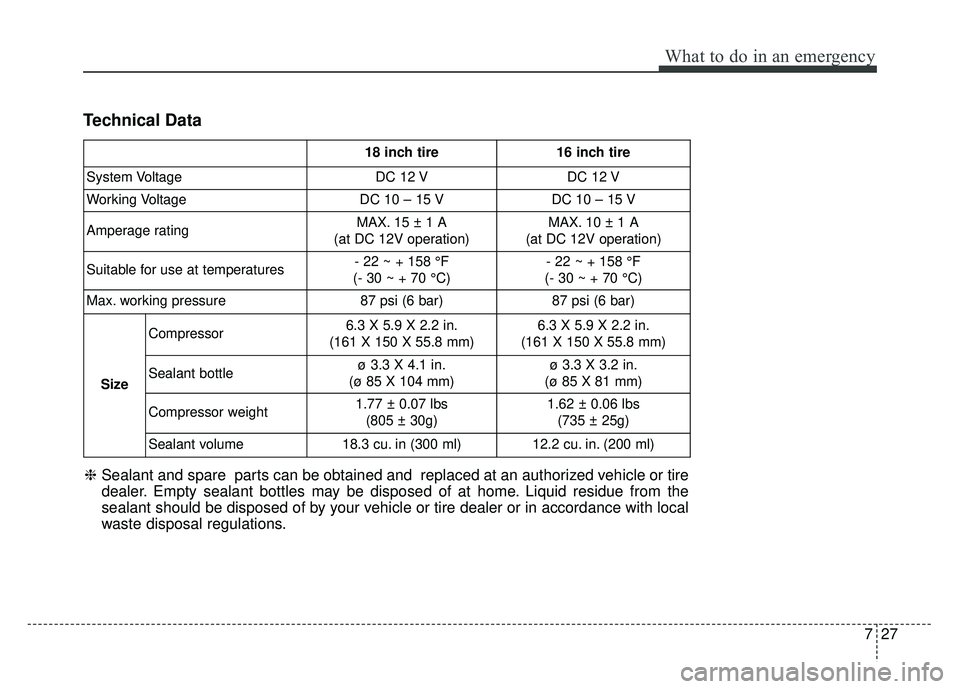
727
What to do in an emergency
Technical Data
18 inch tire16 inch tire
System Voltage DC 12 VDC 12 V
Working Voltage DC 10 – 15 VDC 10 – 15 V
Amperage rating MAX. 15 ± 1 A
(at DC 12V operation) MAX. 10 ± 1 A
(at DC 12V operation)
Suitable for use at temperatures - 22 ~ + 158 °F
(- 30 ~ + 70 °C) - 22 ~ + 158 °F
(- 30 ~ + 70 °C)
Max. working pressure 87 psi (6 bar)87 psi (6 bar)
Size Compressor
6.3 X 5.9 X 2.2 in.
(161 X 150 X 55.8 mm) 6.3 X 5.9 X 2.2 in.
(161 X 150 X 55.8 mm)
Sealant bottle ø 3.3 X 4.1 in.
(ø 85 X 104 mm) ø 3.3 X 3.2 in.
(ø 85 X 81 mm)
Compressor weight 1.77 ± 0.07 lbs
(805 ± 30g) 1.62 ± 0.06 lbs
(735 ± 25g)
Sealant volume 18.3 cu. in (300 ml)12.2 cu. in. (200 ml)
❈Sealant and spare parts can be obtained and replaced at an authorized vehicle or tire
dealer. Empty sealant bottles may be disposed of at home. Liquid residue from the
sealant should be disposed of by your vehicle or tire dealer or in accordance with local
waste disposal regulations.
Page 464 of 616
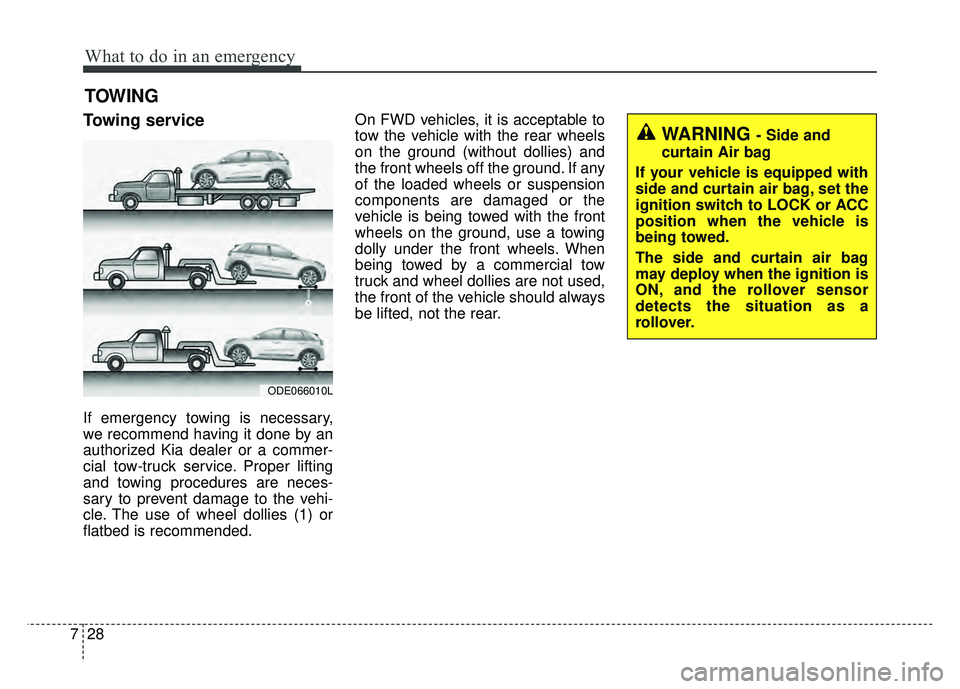
What to do in an emergency
28
7
TOWING
Towing service
If emergency towing is necessary,
we recommend having it done by an
authorized Kia dealer or a commer-
cial tow-truck service. Proper lifting
and towing procedures are neces-
sary to prevent damage to the vehi-
cle. The use of wheel dollies (1) or
flatbed is recommended. On FWD vehicles, it is acceptable to
tow the vehicle with the rear wheels
on the ground (without dollies) and
the front wheels off the ground. If any
of the loaded wheels or suspension
components are damaged or the
vehicle is being towed with the front
wheels on the ground, use a towing
dolly under the front wheels. When
being towed by a commercial tow
truck and wheel dollies are not used,
the front of the vehicle should always
be lifted, not the rear.
WARNING - Side and
curtain Air bag
If your vehicle is equipped with
side and curtain air bag, set the
ignition switch to LOCK or ACC
position when the vehicle is
being towed.
The side and curtain air bag
may deploy when the ignition is
ON, and the rollover sensor
detects the situation as a
rollover.
ODE066010L
Page 465 of 616

729
What to do in an emergency
When towing your vehicle in an
emergency without wheel dollies :
1. Set the ignition switch in the ACCposition.
2. Place the transaxle shift lever in N (Neutral).
3. Release the parking brake.Removable towing hook
(if equipped)
1. Open the liftgate, and remove the towing hook from the tool case.
2. Remove the hole cover pressing the upper (front) / lower (rear) part
of the cover on the bumper.
CAUTION - Towing gear
position
Failure to place the transaxleshift lever in N (Neutral) maycause internal damage to thetransaxle.
CAUTION - Towing
Do not tow the vehicle back- wards with the front wheels onthe ground as this may causedamage to the vehicle.
Do not tow with sling-type equipment. Use wheel lift orflatbed equipment.
ODE066012
ODE066011ODE066014
ODE066015
■Front
■ Rear
Page 466 of 616

What to do in an emergency
30
7
3. Install the towing hook by turning it
clockwise into the hole until it is
fully secured.
4. Remove the towing hook and install the cover after use.Emergency towing
If towing is necessary, have it
done by an authorized Kia dealer
or a commercial tow truck service. If towing service is not available in an
emergency, your vehicle may be
temporarily towed using a cable or
chain secured to the emergency tow-
ing hook under the front (or rear) of
the vehicle. Use extreme caution
when towing the vehicle. A driver
must be in the vehicle to steer it and
operate the brakes.
Towing in this manner may be done
only on hard-surfaced roads for a
short distance and at low speed.
Also, the wheels, axles, power train,
steering and brakes must all be in
good condition.
Do not use the tow hooks to pull a
vehicle out of mud, sand or other
conditions from which the vehicle
cannot be driven out under its own
power.
Avoid towing a vehicle heavier than the vehicle doing the towing.
The drivers of both vehicles should communicate with each other fre-
quently.
ODE066016
ODE066017
■Front
■ Rear
Page 467 of 616
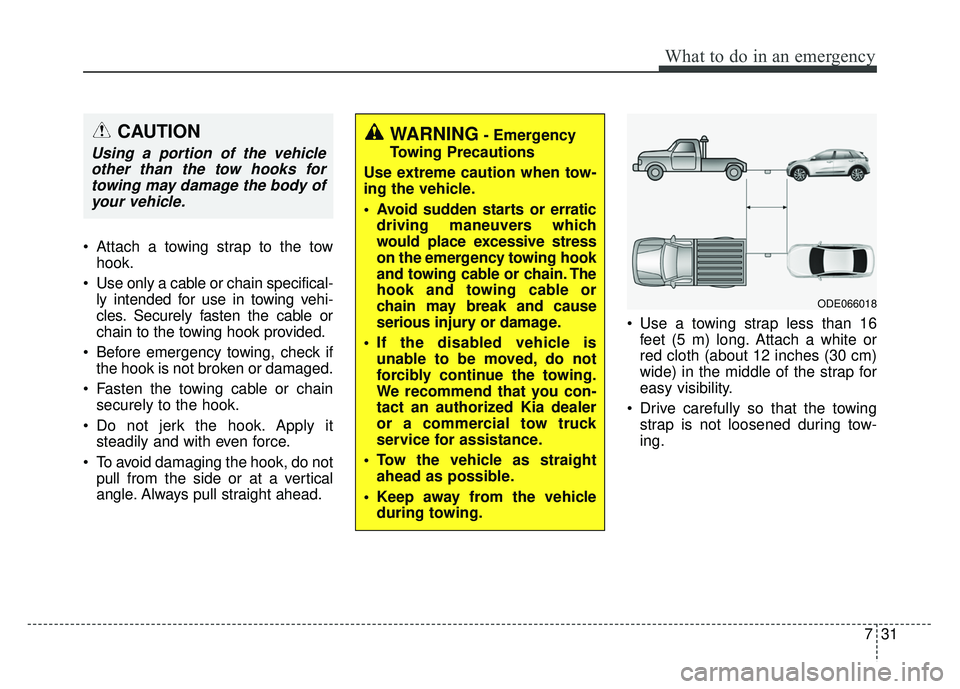
731
What to do in an emergency
Attach a towing strap to the towhook.
Use only a cable or chain specifical- ly intended for use in towing vehi-
cles. Securely fasten the cable or
chain to the towing hook provided.
Before emergency towing, check if the hook is not broken or damaged.
Fasten the towing cable or chain securely to the hook.
Do not jerk the hook. Apply it steadily and with even force.
To avoid damaging the hook, do not pull from the side or at a vertical
angle. Always pull straight ahead. Use a towing strap less than 16
feet (5 m) long. Attach a white or
red cloth (about 12 inches (30 cm)
wide) in the middle of the strap for
easy visibility.
Drive carefully so that the towing strap is not loosened during tow-
ing.
CAUTION
Using a portion of the vehicleother than the tow hooks fortowing may damage the body ofyour vehicle.
WARNING- Emergency
Towing Precautions
Use extreme caution when tow-
ing the vehicle.
Avoid sudden starts or erratic driving maneuvers which
would place excessive stress
on the emergency towing hook
and towing cable or chain. The
hook and towing cable or
chain may break and cause
serious injury or damage.
If the disabled vehicle is unable to be moved, do not
forcibly continue the towing.
We recommend that you con-
tact an authorized Kia dealer
or a commercial tow truck
service for assistance.
Tow the vehicle as straight ahead as possible.
Keep away from the vehicle during towing.
ODE066018
Page 468 of 616
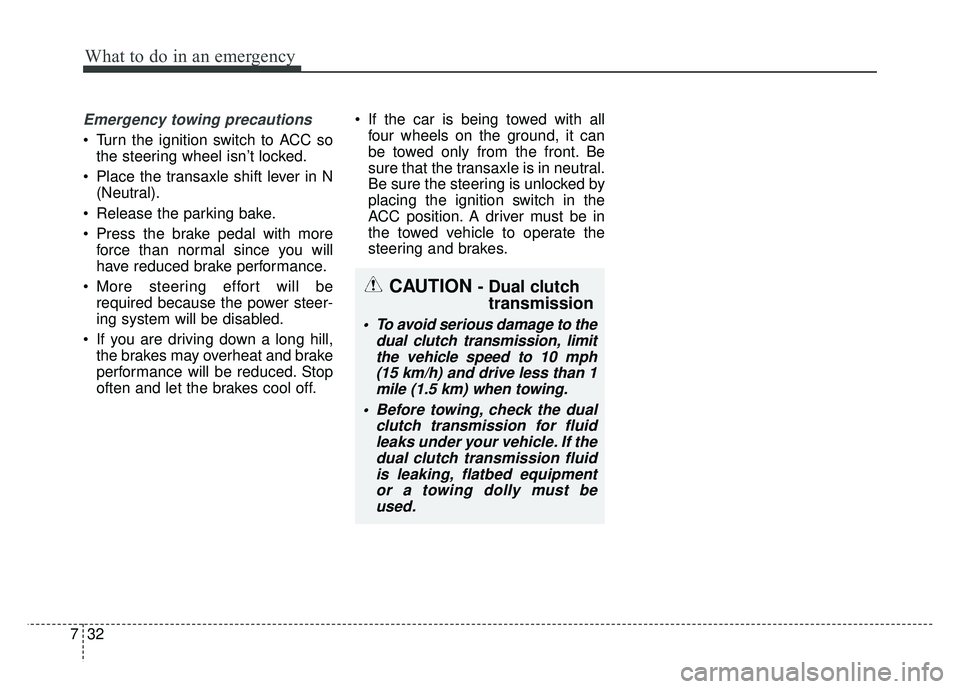
What to do in an emergency
32
7
Emergency towing precautions
Turn the ignition switch to ACC so
the steering wheel isn’t locked.
Place the transaxle shift lever in N (Neutral).
Release the parking bake.
Press the brake pedal with more force than normal since you will
have reduced brake performance.
More steering effort will be required because the power steer-
ing system will be disabled.
If you are driving down a long hill, the brakes may overheat and brake
performance will be reduced. Stop
often and let the brakes cool off. If the car is being towed with all
four wheels on the ground, it can
be towed only from the front. Be
sure that the transaxle is in neutral.
Be sure the steering is unlocked by
placing the ignition switch in the
ACC position. A driver must be in
the towed vehicle to operate the
steering and brakes.
CAUTION - Dual clutchtransmission
To avoid serious damage to the
dual clutch transmission, limitthe vehicle speed to 10 mph(15 km/h) and drive less than 1mile (1.5 km) when towing.
Before towing, check the dual clutch transmission for fluidleaks under your vehicle. If thedual clutch transmission fluidis leaking, flatbed equipmentor a towing dolly must beused.
Page 469 of 616
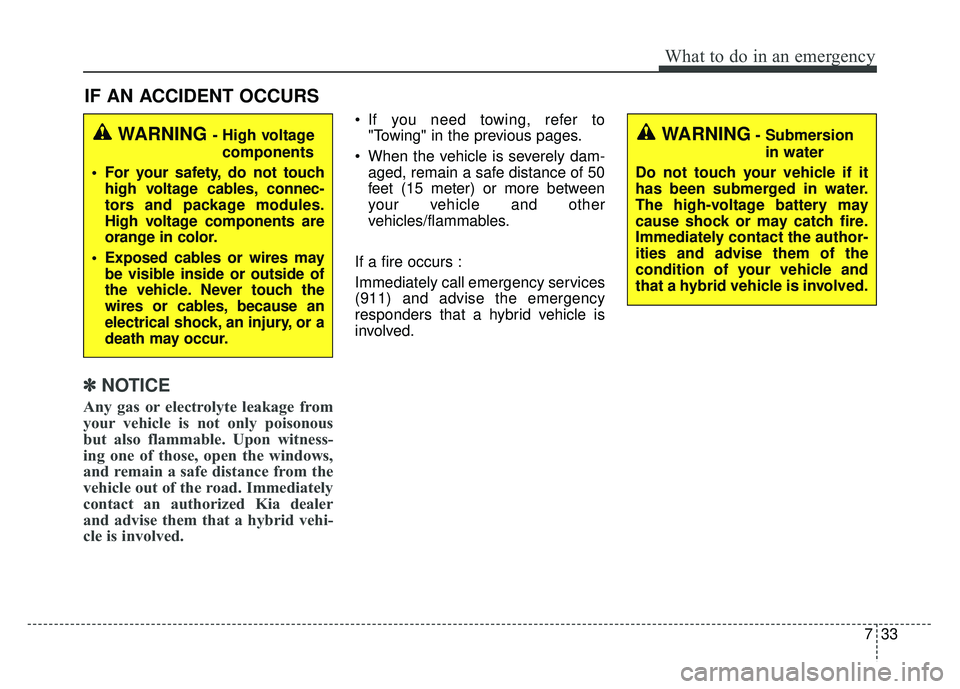
733
What to do in an emergency
IF AN ACCIDENT OCCURS
✽
✽ NOTICE
Any gas or electrolyte leakage from
your vehicle is not only poisonous
but also flammable. Upon witness-
ing one of those, open the windows,
and remain a safe distance from the
vehicle out of the road. Immediately
contact an authorized Kia dealer
and advise them that a hybrid vehi-
cle is involved.
If you need towing, refer to
"Towing" in the previous pages.
When the vehicle is severely dam- aged, remain a safe distance of 50
feet (15 meter) or more between
your vehicle and other
vehicles/flammables.
If a fire occurs :
Immediately call emergency services
(911) and advise the emergency
responders that a hybrid vehicle is
involved.
WARNING - High voltage components
For your safety, do not touch high voltage cables, connec-
tors and package modules.
High voltage components are
orange in color.
Exposed cables or wires may be visible inside or outside of
the vehicle. Never touch the
wires or cables, because an
electrical shock, an injury, or a
death may occur.WARNING- Submersion
in water
Do not touch your vehicle if it
has been submerged in water.
The high-voltage battery may
cause shock or may catch fire.
Immediately contact the author-
ities and advise them of the
condition of your vehicle and
that a hybrid vehicle is involved.
Page 470 of 616
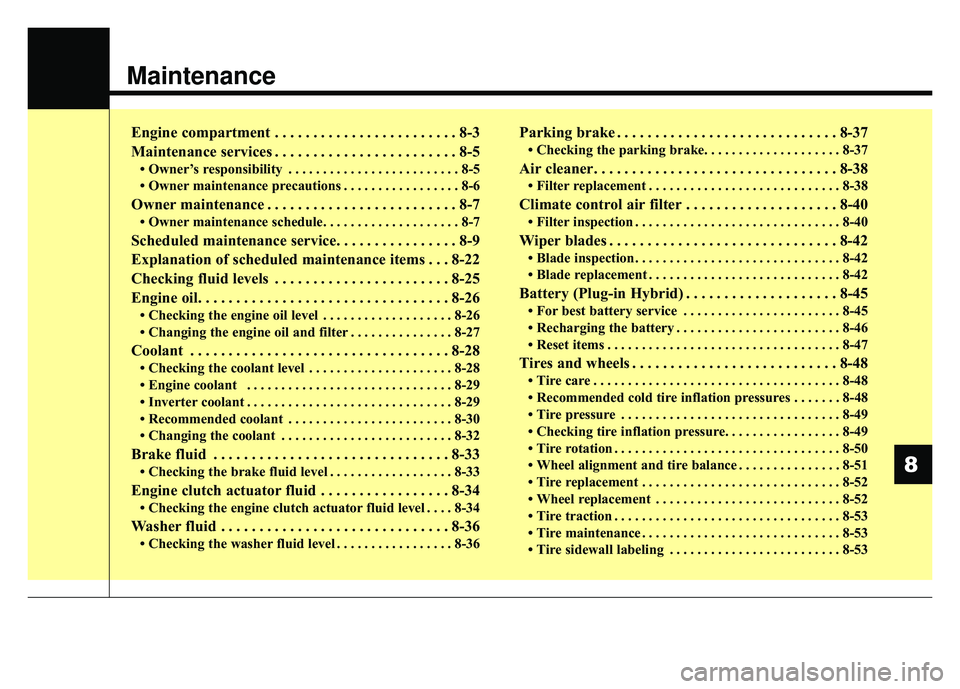
Maintenance
Engine compartment . . . . . . . . . . . . . . . . . . . . . . . . 8-3
Maintenance services . . . . . . . . . . . . . . . . . . . . . . . . 8-5
• Owner’s responsibility . . . . . . . . . . . . . . . . . . . . . . . . . 8-5
• Owner maintenance precautions . . . . . . . . . . . . . . . . . 8-6
Owner maintenance . . . . . . . . . . . . . . . . . . . . . . . . . 8-7
• Owner maintenance schedule. . . . . . . . . . . . . . . . . . . . 8-7
Scheduled maintenance service. . . . . . . . . . . . . . . . 8-9
Explanation of scheduled maintenance items . . . 8-22
Checking fluid levels . . . . . . . . . . . . . . . . . . . . . . . 8-25
Engine oil. . . . . . . . . . . . . . . . . . . . . . . . . . . . . . . . . 8-26
• Checking the engine oil level . . . . . . . . . . . . . . . . . . . 8-26
• Changing the engine oil and filter . . . . . . . . . . . . . . . 8-27
Coolant . . . . . . . . . . . . . . . . . . . . . . . . . . . . . . . . . . 8-28\
• Checking the coolant level . . . . . . . . . . . . . . . . . . . . . 8-28
• Engine coolant . . . . . . . . . . . . . . . . . . . . . . . . . . . . . . 8-29
• Inverter coolant . . . . . . . . . . . . . . . . . . . . . . . . . . . . . . 8-29
• Recommended coolant . . . . . . . . . . . . . . . . . . . . . . . . 8-30
• Changing the coolant . . . . . . . . . . . . . . . . . . . . . . . . . 8-32
Brake fluid . . . . . . . . . . . . . . . . . . . . . . . . . . . . . . . 8-33
• Checking the brake fluid level . . . . . . . . . . . . . . . . . . 8-33
Engine clutch actuator fluid . . . . . . . . . . . . . . . . . 8-34
• Checking the engine clutch actuator fluid level . . . . 8-34
Washer fluid . . . . . . . . . . . . . . . . . . . . . . . . . . . . . . 8-36
• Checking the washer fluid level . . . . . . . . . . . . . . . . . 8-36
Parking brake . . . . . . . . . . . . . . . . . . . . . . . . . . . . . 8-37
• Checking the parking brake. . . . . . . . . . . . . . . . . . . . 8-37
Air cleaner. . . . . . . . . . . . . . . . . . . . . . . . . . . . . . . . 8-38
• Filter replacement . . . . . . . . . . . . . . . . . . . . . . . . . . . . 8-38
Climate control air filter . . . . . . . . . . . . . . . . . . . . 8-40
• Filter inspection . . . . . . . . . . . . . . . . . . . . . . . . . . . . . . 8-40
Wiper blades . . . . . . . . . . . . . . . . . . . . . . . . . . . . . . 8-42
• Blade inspection . . . . . . . . . . . . . . . . . . . . . . . . . . . . . . 8-42
• Blade replacement . . . . . . . . . . . . . . . . . . . . . . . . . . . . 8-42
Battery (Plug-in Hybrid) . . . . . . . . . . . . . . . . . . . . 8-45
• For best battery service . . . . . . . . . . . . . . . . . . . . . . . 8-45
• Recharging the battery . . . . . . . . . . . . . . . . . . . . . . . . 8-46
• Reset items . . . . . . . . . . . . . . . . . . . . . . . . . . . . . . . . . . 8-47\
Tires and wheels . . . . . . . . . . . . . . . . . . . . . . . . . . . 8-48
• Tire care . . . . . . . . . . . . . . . . . . . . . . . . . . . . . . . . . . . . \
8-48
• Recommended cold tire inflation pressures . . . . . . . 8-48
• Tire pressure . . . . . . . . . . . . . . . . . . . . . . . . . . . . . . . . 8-49
• Checking tire inflation pressure. . . . . . . . . . . . . . . . . 8-49
• Tire rotation . . . . . . . . . . . . . . . . . . . . . . . . . . . . . . . . . 8-50
• Wheel alignment and tire balance . . . . . . . . . . . . . . . 8-51
• Tire replacement . . . . . . . . . . . . . . . . . . . . . . . . . . . . . 8-52
• Wheel replacement . . . . . . . . . . . . . . . . . . . . . . . . . . . 8-52
• Tire traction . . . . . . . . . . . . . . . . . . . . . . . . . . . . . . . . . 8-53
• Tire maintenance . . . . . . . . . . . . . . . . . . . . . . . . . . . . . 8-53
• Tire sidewall labeling . . . . . . . . . . . . . . . . . . . . . . . . . 8-53
8